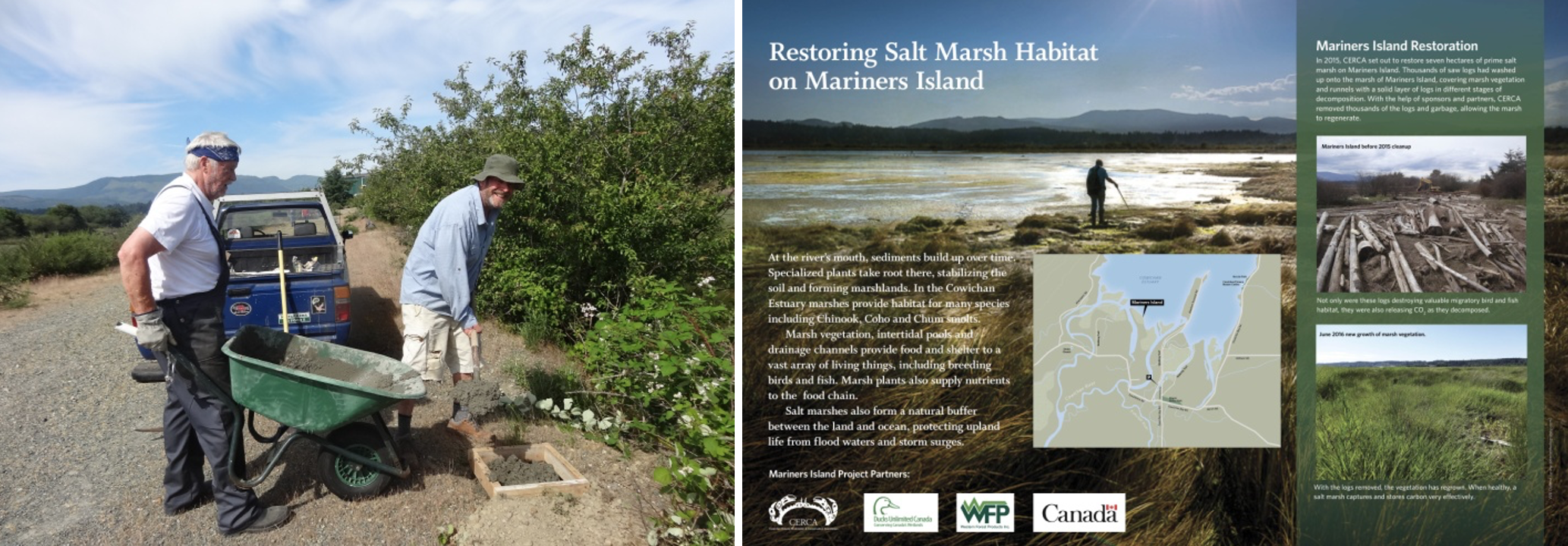Invasive Plants Threatening the Cowichan Estuary
On July 12 and 14 a group of our CERCA volunteers tackled the broom along the spit bordering the northern shoreline of the Western Forest Products' mill pond in the estuary. Unfortunately it happened to be one of the hottest days this year so far, but the broom had to go prior to seed ripening. Our agreement with Western Forest Products was for CERCA to cut and pile up the broom and for WFP to dispose of it. It turned out to be a very smooth and efficient operation. All broom stems were cut as close to the ground as possible. Small-stemmed and younger plants by using clippers, thicker stemmed bushes by using chainsaws and a brush cutter. Ideally cutting should have been done a couple of weeks earlier. Experts suggest cutting "broom in bloom". At this time the plant has the highest vigor and the sap is flowing. The root system will then dry up and die during the summer. We learned not to disturb the soil around broom in order to prevent dormant seeds from germinating as triggered by disturbed soil. Broom seeds can survive many years in the soil.
Cutting broom when it is flowering unfortunately coincides with the bird breeding season. The preferred time should therefore be in late winter/early spring prior to the arrival of migratory song-birds and prior to the breeding season. Although the broom itself provides poor nesting opportunities, it does offer shelter and escape cover to ground-breeders and other creatures. However broom removal allows native plants and shrubs to settle, providing much superior habitat requisites.
Broom in this part of the estuary first appeared in the 80s shortly after construction of the Cowichan River dyke, being built for the protection of the hayfields and meadows of "Blackley's Farm", circling the farmland and joining the elevated mill site at the edge of the salt marsh.
The new dyke provides access to the outer edges of the salt marsh. It has been enjoying high popularity amongst dog walkers and birders for years. However, meanwhile the flanks of the dyke are covered by broom crowding out and preventing any native vegetation to establish.
For the past two years CERCA has tried in vain to find out who actually owns the dyke and who is responsible for its maintenance. It was not until earlier this year that legal Government counsel decided that BC's Ministry of Forests, Lands and Natural Resources should assume ownership. At least we now know whom to approach for a permit to combat the broom along the trail, planned for March 2019. The broom has to be removed soon before it starts colonizing the old dykes of the reclaimed salt marshes adjacent to the trail. They are covered by a rich diversity of native shrubs constituting high quality wildlife habitat.
We also used the broom cutting opportunity to prepare the concrete pads for the four interpretative trail signs to be placed along the spit. Western Forest Products donated the money for two of the signs. One of them describes the highly successful joint CERCA/WFP/DFO Mariners Island salt marsh rehabilitation Project. You may recall that we removed over 10 0000 saw logs washed up onto the Mariners salt marsh over decades, destroying large sections of highly productive marsh vegetation.
CERCA's broom busters in action..... Even Uta, with 97 years of age CERCA's oldest member, took part in this action.
Pouring concrete pads for the interpretative signs. The sign describing the Mariners Island salt marsh rehabilitation project is strategically placed over-looking Mariners Island.
I take this opportunity to thank all CERCA volunteers who took part in this activity and Western Forest Products for their cooperation.
Dr. Goetz Schuerholz
CERCA Chair





